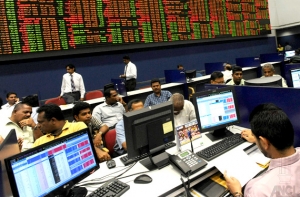
Tuesday, 1st July 2014
By Ken Wangdong - Markets Analyst, Money Morning

Trading at Colombo stock Exchange
After five years of peace, Sri Lanka is getting it all back together. Despite the violence and the civil war, which are still so vivid in our memory, Sri Lanka is close to becoming an economic miracle.
In numbers terms, over ten years of high growth qualifies Sri Lanka as an emerging market star. The Colombo stock index reflects that growth.
Just like there is a sense of fear in the Sri Lankan media, global investors don’t like instability. As a result, most investors missed a 700 per cent + return opportunity over the last 13 years.
And remember that the US index only returned 40 per cent in the last 14 years.
Chinese tourists keep their lights on
When the civil war ended in May 2009, the Chinese keenly filled the economic void.
Colombo will soon get new trains, provided by CSR Corp (HKG:1766), a powerful state-owned enterprise (SOE) in China. Under the direct management of the Ministry of Transport, CSR Corp is the company that spearheads China’s transportation technology and research.
It supplies all the subways, speed trains/bullet trains, freight trains and locomotives in China.
Tourism is a key industry for Sri Lanka. It’s also the most sensitive industry to instability and violence. While the north of Sri Lanka has suffered decades of civil strife, it’s the south and west that are most at risk. Why? That’s where you’ll find the fancy hotels and resorts.
It’s true that Chinese tourists are resilient, such as in the case of travelling to Malaysia. Chinese tourists saw the disappearance of an entire plane and the kidnapping of Chinese citizens in Malaysia. But even that didn’t stop them going.
However, another explosive situation in Sri Lanka won’t be good news for tourism.
It’s low season in June. Yet thousands of Chinese visitors pour into the resorts and beaches of Sri Lanka. They’re helping to keep the hotels’ lights on at night.
Fundamentals
In terms of economic fundamentals, Sri Lanka has achieved a miracle. The country has lifted its GDP per capita three times in the last 20 years.
Sri Lanka is among the fastest growing nations in the world. It’s one of the few countries that has kept average growth above 5 per cent over the last four to five decades. And for the rest of this decade, Sri Lanka will continue to grow at 6 per cent. That’s on a par with India. With a GDP per capita of US$6,530, Sri Lanka is fast approaching the middle income benchmark.
The growth mechanics of the country are straightforward. Increasing investments, a gradual urbanisation process, and expanding services have led to a growing economy.
The government has pursued large-scale reconstruction and development projects. It has targeted growth in war-torn and poor areas. Sri Lanka has also focused on developing small and medium enterprises and increasing farm productivity.
Sri Lanka has only 10.6 per cent of its population on farmlands. The rest are mostly in services (57 per cent of the total) and secondary industries such as manufacturing (32.4 per cent). Household consumption accounts for 70 per cent of the entire economy.
700 per cent index return
Sri Lanka is one of those emerging markets that have had an incredible return on its stock index. The Colombo index has clocked up a 725 per cent return over the last 13 years. After adjusting this for the currency depreciation of the Rupee against the Aussie dollar, the real return is still 525 per cent.
This figure really puts the All Ordinaries to shame.
The All Ordinaries could only produce an 80 per cent return over 13 years. However, that is still better than the return on the US market, which was 40 per cent. That return is even worse after adjusting for exchange rate movements.
See graph
The model forecast above shows the trajectory of the Colombo index in this decade. What you may notice is that there is quite a bit of volatility in the Sri Lankan market. Looking ahead, my analysis suggests that a weak market scenario would only give you a 10 per cent return in the rest of the decade, while a strong market performance could give investors a 109 per cent gain.
On average, it could achieve a 60 per cent return.
There is also an exchange rate component. Most emerging market currencies tend to depreciate against the Aussie dollar. That’s due to a high growth differential and a high inflation differential. That means higher inflation leads to faster depreciation in the currency.
The Aussie dollar is likely to remain strong due to a strengthening in iron ore and commodity pricing. This will occur once China’s overcapacity ends.
List of problems
However, there is also a list of challenges for the Sri Lankan government.
The Sri Lankan economy and its stock market have strong links to the global commodity market, since its agricultural exports contribute to overall growth. Therefore, global demand and commodity pricing remain factors to watch. The country’s trade deficit is an ongoing concern. However, this gets a boost somewhat by strong remittances from Sri Lankans living and working abroad. Sri Lanka remains a strong emerging market. The country has a lot to do in terms of fixed investments, infrastructure, consumer products, services and other areas.
In short, Sri Lanka is a small emerging economy to watch closely.
Courtesy: MONEYMORNING
See more at: http://www.dailynews.lk:8082/?q=features/sri-lankan-economy-s-chance-shine




